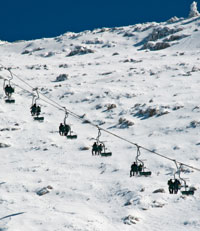Israel's sole ski resort, on the
Hermon Mountain, turns 40 this season. In an area hardly noted for winter sports, Ski Hermon has been a success story.
"This site is unique - it's the only ski resort in the world inside a military area, and operates in complete cooperation with the army," says Shaul Ohana, the site manager. The geographic location affords outstanding views of the Hermon mountain range and northern Israel.
View from Mt. Hermon ski resort
"We're at the meeting place of borders, and there's no room to expand," says Ohana. "The site covers a total of 2,432 dunams [about 600 acres] - it's very limited. The Syrian Hermon, which is higher, is close but out of reach."
Unlike the vast majority of ski resorts worldwide, Ski Hermon is not based in some hillside village. It stands alone above the Druze village of Majdal Shams. Most of the ski instructors and other workers at the resort are Druze. Other staff members hail from the nearby Jewish village of Neveh Ativ. This working relationship has proved mutually beneficial for both communities. "We live in complete harmony," says Ohana, a Neveh Ativ resident. "There are absolutely no problems."
Open winter and summer
It's worth keeping an eye on the weather forecast, because once snow falls on the Hermon range, the resort can quickly fill to capacity. "We can cater to 12,000 visitors a day, including 2,000 skiers," says Ohana.
The site is open 364 days a year. About 300,000 visitors pass through its gates every winter. Another 40,000 come during the tranquil summer months, when the cafeteria at the summit, reached by cable car, becomes the launching point for hiking in the surrounding hillsides and biking through awesome mountain trails - including two technically challenging 4.5-kilometer downhill trails.
The ski resort opened in 1971 with the inauguration of its first cable car. But that was soon insufficient to serve the handful of Israelis who knew how to ski and the hoards of visitors enjoying the rare sight of snow. Four decades on, the site boasts 10 chairlifts and cable cars, 2,500 sets of ski equipment for rent, cafeterias, restaurants and shops, a ski school and 46 kilometers of trails of various levels. The number of Israeli skiers has mushroomed in parallel - an estimated 40,000 now know how to ski.
No longer only for daredevils

Ski Hermon offers 10 chairlifts and cable cars |
Israel is not exactly a major stop on the international winter-sports tourism map, admits Ohana. "Most of the visitors are Israeli, mainly young people and families, while tourists in the know include it in their itinerary. Skiing and snowboarding attract young people because of the adrenaline rush. They are crazy about extreme sports."
Which brings us to a thorny issue: In the site's early days, barely a day would go by without some gung-ho paratrooper breaking a limb - or worse - the first time he donned skis.
"There used to be a big problem here with young Israelis' attitudes - you couldn't teach them anything," says Ohana. "All that has changed. Now many Israelis ski abroad and they've learned what not to do. Our ski courses here are of the highest professional level. We've also learned our lessons. Now we don't allow people on the slopes if they don't know what they're doing."
Rising standards
Stanley Rubinstein has been an integral part of the Israeli ski scene since its inception. "I made aliyah from New York in July 1971 and got a job as a ski instructor when the first chair lift started working that December," he recalls. "I worked as a ski instructor for seven or eight years, and have been involved ever since."
Rubinstein notes that "in the 1970s and early 1980s the mountain would be covered in snow from January to mid-March. Now they get an average of 10 to 15 days of snow each winter. It's all because of global warming. We're dependent on the heavens," shrugs Ohana. "Last year we only had two or three days of snow, and 10 days' skiing. One degree Celsius can make all the difference between rain and snow. The last few years have been difficult in that sense." The year 2012 opened more optimistically, with significant snowfall in January allowing for the opening of the slopes.
Snow blankets the ground at the lower station of the cable car (Photo: Ministry of Tourism)
Yet Rubinstein, the former chairman and honorary president of the
Israel Ski Federation, who still participates in masters' races in Europe, has seen a rise in interest among the Israeli skiing fraternity.
"There are far more skiers now than there used to be. It used to be that everyone knew everyone else. Now about 50,000 Israelis go to ski in Europe every winter." And the standards are definitely higher, says Rubinstein. "Skiing in Israel has benefited from the number of high-level immigrant athletes," he says. "Seven or eight Israelis are involved in competitive skiing. They spend the entire winter in Europe, training and competing." One Israeli, Mikhael Renzhin, finished a respectable 38th place in the Giant Slalom in the 2006 Winter Olympics in Turin.